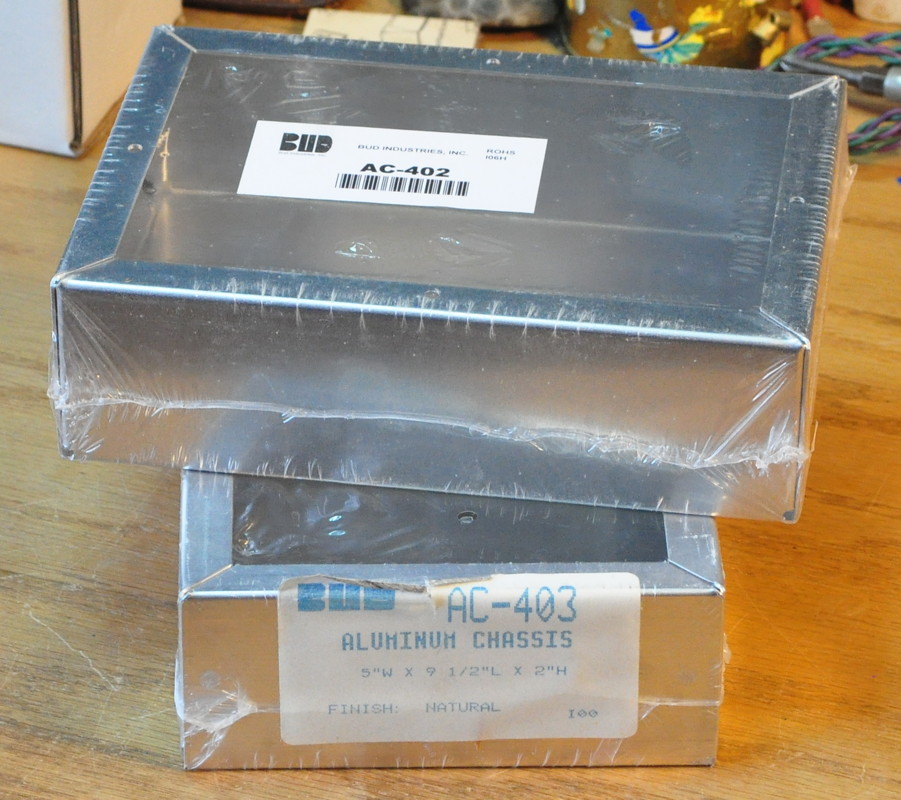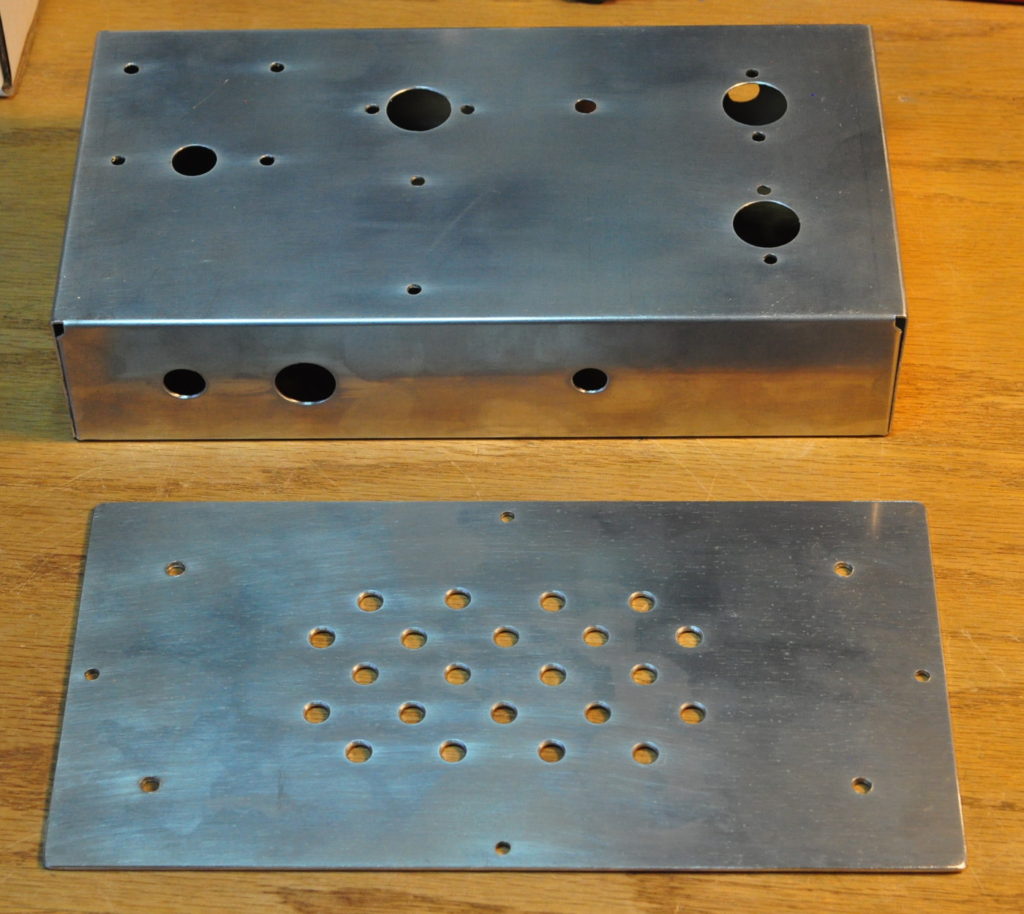While waiting for appropriate temperatures to paint and apply oil finishes, I’ve been working on a simple preamp project. It’s only a handful of parts and to avoid complications with finishing a handmade chassis, I decided to use a preformed aluminum project box I had sitting on my shelf. I quickly regretted that decision.
I’ve gotten used to working with hand selected materials. For the metal plates in amplifiers I typically use an alloy of aluminum common in the aerospace industry, 6061-T6 in 0.080″ (≈2mm) thickness. This alloy is strong yet highly machinable and tooling generally leaves a nice smooth finish. And because of the manner in which I build most of my wood chassis, I am normally working with flat sheets of aluminum and sometimes small angle stock in projects like the 6EM7 Vertical Amp or the Zebrawood amp.
The pre-formed project box I chose to use is one from a windfall I stumbled into about a decade ago. I have a sizable stack of these boxes. These project boxes are ubiquitous in the electronics industry; generally folded from relatively thin aluminum or steel and spot welded at the corners. The ones I have are made by Bud Industries, but there are numerous other manufacturers. They all look mostly the same. Here are a couple from my parts closet.
These boxes are formed from 0.040″ aluminum. I don’t know what alloy it is but it’s kind of gummy and doesn’t take a finish particularly well.
After marking up the box I retired to my shop to center punch holes and do some drilling. This is when the problems started. The tooling was chattering and not cutting particularly well. Even when using my typical cutting fluid Relton A-9. The cutters were leaving nasty burrs on the back side of the holes and trying to drift while being drilled. Getting these burrs off the insides of holes inside the box was a particular difficult chore. In addition, due to the soft and thin material used, the box would distort when I started to drill so each hole had to be drilled very slowly and with a very light touch. I couldn’t believe that such a simple task could be giving me so much trouble.
I finally prevailed in getting the chassis drilled but it did take an exceptional amount of fussing with details to make things work out alright. Here’s how it turned out.
The plate in front of the chassis is a bottom cover I made for the project box out of a piece of my 6061-T6 80mil aluminum. It took surprisingly little time after fussing with the chassis all morning. I’ve taken to using the cast aluminum boxes like the BUD CU-476 for small projects. Compared to the sheet metal ones, these cast boxes are a joy with which to work.
So my question is how do people like using boxes like these sheet metal project boxes? I know that Hammond makes these types of boxes out of aluminum and of steel but I’ve never used one of theirs. Are there some on the market which are better than others?
I know that my recommendation is to build your own chassis if possible. Preferably out of the best quality wood and metal you can afford. Given the cost of building even simple tube projects, having a nice chassis doesn’t seem like too much to ask. What’s your opinion?



I have only previously used a box from Hammond for the 300b amp which follows your design for the most part. Being my first build and having basic tools made drilling accurate holes challenging with mistakes aplenty but in the end got there. I used a spray can to coat it and I think that worked ok after sanding back runs a few times. Your first 6v6 project inspired me to try and do something similar with Australian “lacewood” called silky oak here. I admire their golden flowers in the later winter and spring. I am hoping this turns out for use in the 6AS7 set project— making slow progress due to limited time at the moment. It is extra work and cost but in the end matching the electronics with a nice timber/aluminium chassis is somewhat satisfying.
I have a cnc plasma cutter which I use for most stuff. I generally use top and bottom plates of 14 Ga (0.075) steel with a wood frame with recessed steel side plates also 0f 14 Ga steel for power entry, and user controls, audio in and out, etc. This is very similar to many of your projects. The plasma cutter makes cutting holes for tube sockets, etc very accurate and easy, but most of the small mounting screw holes I drill on my drill press. I’ve done some projects in aluminum but dislike it because the plasma cutter leaves a rough edge on AL, though its somewhat easier to work with since it’s softer. I have an inexpensive powder coat gun and old kitchen range for powder coating small projects and it gives suprisingly good results and to me it is much simpler, faster and cleaner than any spray paint including rattle cans, plus no fumes. I don’t have a sheet metal bender so making a bent chassis is difficult but I have a harbor freight shop press which i’ve used a few times, typically using plasma cut slots on the bend lines to make it easier, but I don’t like this too much. I like the wood and painted metal combo, and found your latest copper experiments interesting and very attractive with the purple heart wood.
Plasma cutters are awesome tools. But a little out of my league unfortunately.
I normally use plastic enclosures (solid state stuff).
I have used Bud boxes in the past for various projects. Best way to drill is to back up the metal with scrap wood so you have a solid surface to drill into, but yes you still get some burrs. As far as finish goes, the raw aluminum don’t seem to like paint at all, never had any success painting them. If I wanted a finish on the box, I bought the factory pre-finished ones (grey hammertone).
The boxes you have are chassis meant to hide inside an outer enclosure.
I generally don’t buy enclosures either and try to use something I already have. Since your picture had a part number, I looked it up at Hawk Electronics which has the best price on the 6K88VG transformer. The AC:402 is $10 there, if a person wanted to combined shipping costs with other preamp components.
And only $12.10 USD for the AC-403 which is what I used for my project chassis. Hawk Electronics seems to have some very good prices on a lot of items.
I’ve never used these types of preformed aluminium boxes, nor sheet metal. I get as much pleasure (or even more pleasure), building a wood and sheet aluminium chassis, as wiring and listening to the amp. I don’t have as many woodworking or metalworking tools as I would like. 2mm thick aluminium and 2cm thick wood are relatively easy to work with if you have a minimal tool set, so for me, building my own is the only way to go. I’m recently retired and prefer that a project takes a month, not a week, That probably colors my preference as well.